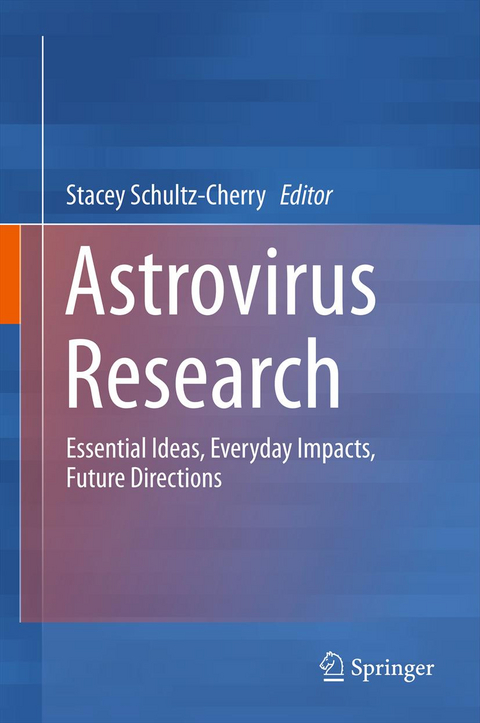
Astrovirus Research
Essential Ideas, Everyday Impacts, Future Directions
Seiten
2014
Springer-Verlag New York Inc.
978-1-4899-9406-6 (ISBN)
Springer-Verlag New York Inc.
978-1-4899-9406-6 (ISBN)
Astroviruses were first identified in the feces of children in 1975. Since then, they have been found in ~ 3 to 20% of children with diarrhea. Given that serological studies have demonstrated that up to 90% of children have been exposed to at least one strain of astrovirus by age 9, the prevalence of infection may be much higher. Supporting this are studies demonstrating that astroviruses can also be isolated in a subset of asymptomatic individuals, suggesting that a proportion of infected individuals shed the virus asymptomatically or for some time after the resolution of other symptoms of infection. Asymptomatic carriers may be a major reservoir for astroviruses in the environment and could contribute to dissemination of the virus. Astroviruses are extremely stable in the environment and can be transmitted nosocomially, directly from infected individuals and potentially animals, and through contaminated food and water. Although typically an acute disease, astrovirus infection inpremature infants may be associated with the development of necrotizing enterocolitis and in new-onset celiac disease in children. Immunocompromised children are even more susceptible often developing persistent infections that lead to wasting or even systemic infections associated with fatal encephalitis.
In spite of its importance, little is known about astrovirus pathogenesis, molecular biology, epidemiology, or cell biology. The goal of this book is to provide the latest and most up-to-date information on this medically important and rapidly evolving group of viruses. It will include sections on the history of astroviruses and their disease in humans; information on viral replication and immune responses; new information on how astroviruses induce disease including the expression of a viral enterotoxin regulating intestinal epithelial cell tight junctions, the isolation and identification of new astrovirus genotypes in mammals including humans, and astroviruses of veterinaryimportance. Finally, the book will also introduce the complexity of astrovirus epidemiology and potential as an important new zoonotic disease, and its role in food-borne disease. This will be the first book of its kind and will be of great interest to microbiologists, virologists, infectious disease specialists, immunologists, pediatricians, public health and food safety experts, veterinarians, poultry industry specialists, and researchers and clinicians interested in enteritis.
In spite of its importance, little is known about astrovirus pathogenesis, molecular biology, epidemiology, or cell biology. The goal of this book is to provide the latest and most up-to-date information on this medically important and rapidly evolving group of viruses. It will include sections on the history of astroviruses and their disease in humans; information on viral replication and immune responses; new information on how astroviruses induce disease including the expression of a viral enterotoxin regulating intestinal epithelial cell tight junctions, the isolation and identification of new astrovirus genotypes in mammals including humans, and astroviruses of veterinaryimportance. Finally, the book will also introduce the complexity of astrovirus epidemiology and potential as an important new zoonotic disease, and its role in food-borne disease. This will be the first book of its kind and will be of great interest to microbiologists, virologists, infectious disease specialists, immunologists, pediatricians, public health and food safety experts, veterinarians, poultry industry specialists, and researchers and clinicians interested in enteritis.
Preface.- Epidemiology of Human Astroviruses.- Replication Cycle of Astroviruses.- Astrovirus Structure and Assembly.- Astrovirus Pathogenesis.- Immune Responses.- Astrovirus Taxonomy.- New Human Astroviruses.- Astrovirus Infections in Animal Mammalian Species.- Avian Astroviruses.- Index.
| Erscheint lt. Verlag | 9.11.2014 |
|---|---|
| Zusatzinfo | XIV, 186 p. |
| Verlagsort | New York |
| Sprache | englisch |
| Maße | 155 x 235 mm |
| Themenwelt | Medizin / Pharmazie ► Medizinische Fachgebiete ► Mikrobiologie / Infektologie / Reisemedizin |
| Studium ► Querschnittsbereiche ► Infektiologie / Immunologie | |
| Naturwissenschaften ► Biologie ► Biochemie | |
| Naturwissenschaften ► Biologie ► Mikrobiologie / Immunologie | |
| Naturwissenschaften ► Biologie ► Zoologie | |
| Sozialwissenschaften ► Soziologie | |
| Schlagworte | Astrovirus • celiac disease • epidemiology • zoonotic |
| ISBN-10 | 1-4899-9406-8 / 1489994068 |
| ISBN-13 | 978-1-4899-9406-6 / 9781489994066 |
| Zustand | Neuware |
| Haben Sie eine Frage zum Produkt? |
Mehr entdecken
aus dem Bereich
aus dem Bereich
Buch | Softcover (2023)
Lehmanns Media (Verlag)
CHF 27,90


